What is Torrent? How to use Torrent?
Let's see what torrent files are and how to use them in the following article.
What is Torrent?
A torrent file is a file that contains metadata details where files and folders scattered across the Internet are found. Torrent files often contain information related to the list of trackers (basically servers that list where to find files and folders online) that the torrent requires to complete the download.
Torrent files do not contain the files you download. It includes information about those files and acts a bit like a table of contents for the files you want to download. A torrent file uses a standardized structure:
- Announce: Include at least one URL for the tracker.
- Info File : Varies depending on the number of files shared. Includes a complete list of files to share when multiple files are included in a single download, including file size in bytes and path to the actual file.
- Length: File size, for a single file.
- Name: Suggest a file name and path for a file.
- Piece Length: Indicates the number of bytes per piece. Each file is divided into pieces of fixed capacity, and Piece Length indicates how many bytes are expected in each piece.
- Pieces: List of hashes that link parts in the file together. In case there are multiple files, the list of sections refers to the Info File for the order of the files.
How do torrents work?
In short, a torrent file serves as the key to start downloading the actual content. When someone wants to receive a shared file (like books, music, documents, etc.), they must first download the corresponding torrent file directly or by using a magnet link.
Then, BitTorrent software is required to open this file/link. After the BitTorrent software scans the file/torrent link, it will need to find the location of the seeders sharing the corresponding file. To do so, it tries to connect to the list of identified trackers (from the torrent file metadata) and tries to connect directly. If successful, the appropriate content will then begin to be transferred.
Note : Torrent downloads can be done as segments, so in effect you are actually downloading small parts of the content, then all the parts will be fully assembled .
Some commonly used terms in torrents
Here are some useful terms to know when dealing with torrents:
- Seed : Seed torrent means share it. The number of seeds of a torrent is the number of people sharing the entire file. Zero seed means no one can download the entire file.
- Peer : Peer is the person who downloads the file from the seeder but does not have the full file yet.
- Leech : Leecher downloads more than uploads. Instead, the leecher may not upload anything after the full file has been downloaded.
- Swarm : A group of people downloading and sharing the same torrent.
- Tracker : A server that keeps track of all connected users and helps them find each other.
- Client : Program or web service used by torrent files or magnet links to understand how to download or upload files.
Why do people use torrents?
Torrent files are a core part of distributed P2P (peer-to-peer) file networks. Torrent files tell the BitTorrent client where to find the files you want to download from other users connected to the P2P network.
People use torrents for many reasons, but the crux of the matter is the ease of sharing files between users. Consider a Linux distribution, such as Ubuntu or Debian. These Linux distributions offer a way to download operating systems for free using torrents to reduce strain on servers, reduce hosting costs, and potentially reduce the time it takes to download a particular file.
How to distribute Torrent
After creating a torrent, the creator can share one of two things: The .TORRENT file or the hash of the torrent, often called a magnet link.
Magnet links are a simple way to identify torrents on the BitTorrent network without having to process the TORRENT file. It is unique to that particular torrent, so even though the link is just a string of characters, it is still equivalent to having a file.
Magnet links and TORRENT files are often listed on torrent indexes, which are sites built specifically for torrent sharing. You can also share torrent information via email, text, etc.
Because magnet links and TORRENT files are just instructions for BitTorrent clients to understand how to retrieve data, sharing them is quick and easy.
A torrent file is not too useful unless it is used with a client program. Here's an example of a torrent opening in a text editor - you can see how pointless it is to view torrents this way.
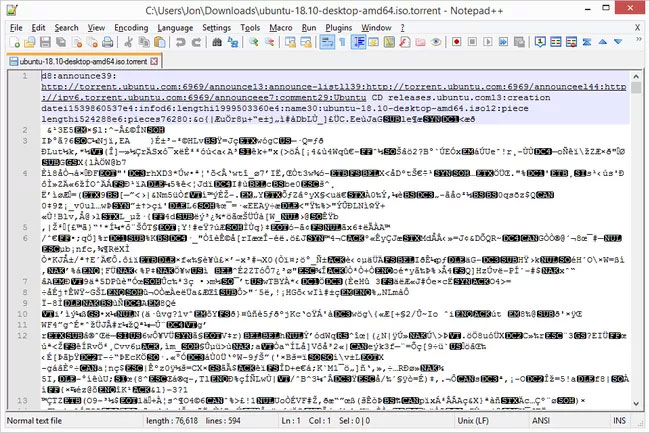 What is Torrent? How to use Torrent? Picture 1
What is Torrent? How to use Torrent? Picture 1
Is torrenting legal?
Have! So as long as you download legal content, using torrents is completely acceptable. However, if you start downloading illegal content using torrents, things will be different.
Internet service providers (ISPs), copyright holders, etc. may monitor your Internet connection for evidence of torrent use. If you want to stop your ISP or anyone else from snooping on your data, you need a VPN. Check out our list of the best VPNs today for some suggestions.
Where can torrents be found?
To find torrent files, users often go to popular websites like The Pirate Bay and Kickass Torrents . Although torrenting is technically legal, over the years it has come to be synonymous with illegal activity, as countless users share pirated content unchecked.
Basically, you have to know what content is legal and what content is illegal before starting any torrent connection. If you are looking for torrent sites that provide legal torrent content, check out this list of sites that allow you to download torrents legally.
Why are torrents dangerous?
Downloading torrents is always potentially dangerous due to the fact that other applications can see your IP address. A lot of production and recording companies hire traffic and report that all these IP addresses are found downloading torrents, which are then passed on to the ISP. ISPs will then contact law enforcement agencies to prevent the file from being downloaded further, which may include detaining operators or users.
Connecting to a virtual private network (VPN) will allow you to change your IP address and remain anonymous while downloading torrents. This is an important tool to use when downloading torrents, keeping your ISP from knowing what you're doing.
How to use torrents?
The first thing you need is a BitTorrent client. There are many clients available. qBittorent is highly rated and available for all major operating systems. Plus, it's free and open source, so it's a great place to start.
After installing qBittorrent, you need a torrent file to test the BitTorrent client. Many Linux operating systems use torrents to distribute files. Go to the Ubuntu download page and scroll down to the BitTorrent section. Select the latest version of Ubuntu Desktop (20.04 at the time of writing) and wait for the file to download.
When the file finishes downloading, double-click to open. The torrent file will automatically open the BitTorrent client. If you have qBittorent installed, it will open and ask if you want to create a client for your default torrent option. Select Yes if you want to do so, then continue.
BitTorrent client tabs
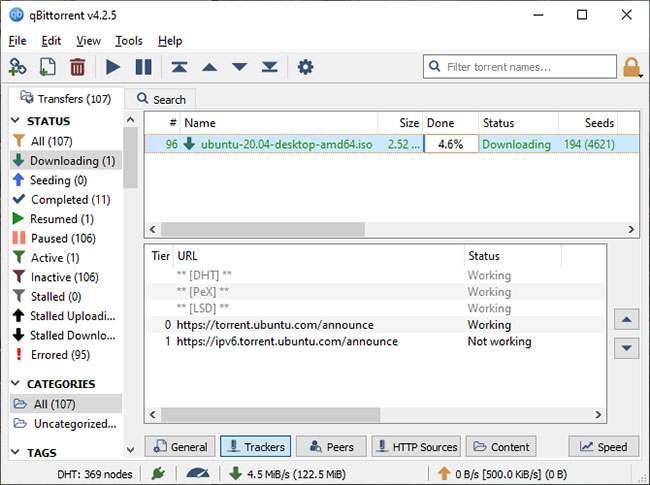 What is Torrent? How to use Torrent? Picture 2
What is Torrent? How to use Torrent? Picture 2
The Ubuntu Desktop torrent file will load in qBittorent and start downloading automatically. At the bottom of the qBittorent window, you will see tabs labeled General, Trackers, Peers, HTTP Sources , and Content .
Select the Peers tab. Here you can see a list of every user that the BitTorrent client is currently connected to, to download files, upload files or prepare one of those actions depending on the client settings.
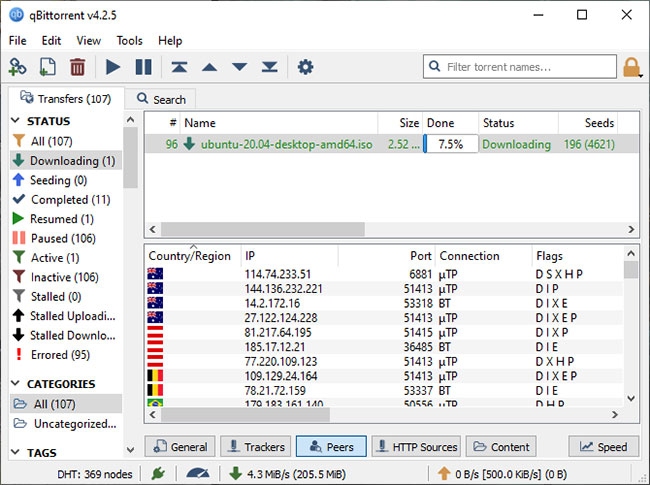 What is Torrent? How to use Torrent? Picture 3
What is Torrent? How to use Torrent? Picture 3
Now, select the Content tab. This tab displays a list of files you are downloading for the selected torrent file. The Ubuntu Desktop torrent file contains a file that you can see in the Content tab. If you have downloaded a torrent file that links to multiple files or folders, you can manage them from this tab.
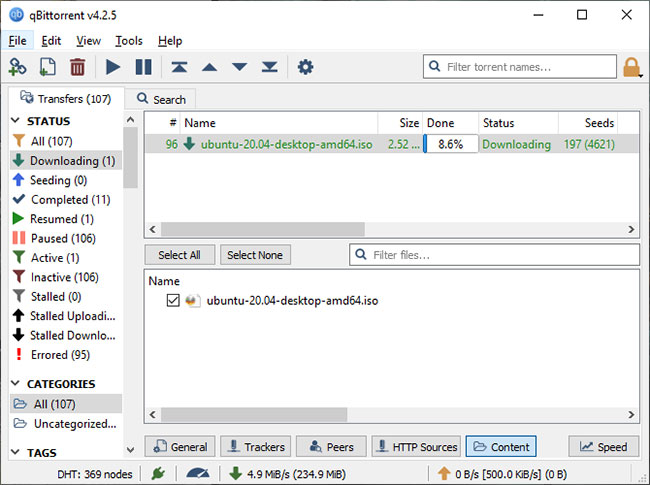 What is Torrent? How to use Torrent? Picture 4
What is Torrent? How to use Torrent? Picture 4
For example, you can deselect specific files or folders so they don't download, or assign individual files higher priority for downloads on the network.
Finally, below the tabs, you will find two small boxes. One has a green arrow, indicating download speed, and one has an orange arrow, indicating upload speed. If you want to limit the client's download or upload speed, you can change the options here. Remember that these speeds apply to your entire BitTorrent client, not just an individual torrent file.
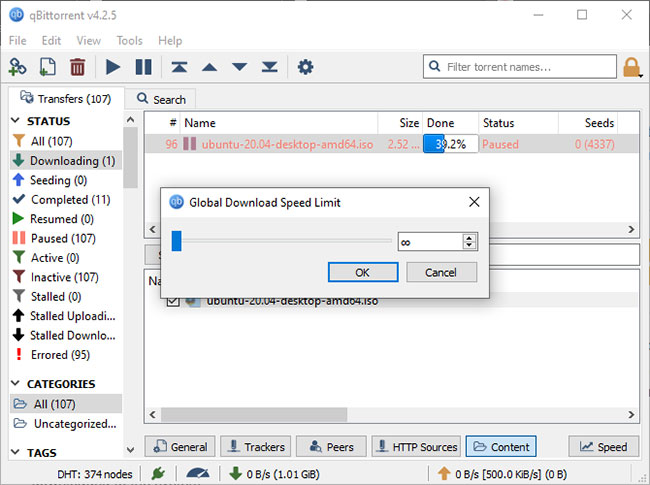 What is Torrent? How to use Torrent? Picture 5
What is Torrent? How to use Torrent? Picture 5
You should read it
- 9 tools to download the best torrent files
- Top 5 best VPN apps for Torrent 2021
- 5 best torrent clients for Windows
- How to download Torrent file by IDM?
- How to set up Coc Coc default download torrent
- 10 ways to increase download speed of Torrent
- How to view torrent file contents using Torrent Player PRO
- How to Download and Open Torrent Files
- 4 ways to bypass blocked Torrent connection
- Top 22 most popular torrent sharing sites
- Top 3 Torrent downloaders, high speed Torrent downloaders
- The launch of uTorrent Web downloads torrent files right from the browser
May be interested

Quick and simple ways to lock Windows 10, 8.1, 7, 11 computer screen

Instructions for installing and using Avast Free Antivirus to effectively remove viruses on your computer

How to install Avira, anti-virus software for computers and laptops

How to set a Windows 10 password, set a password for Windows 10 computer

How to install Deep Freeze, software to freeze computer hard drives

How to set up Windows Defender to increase defense capabilities






 9 tools to download the best torrent files
9 tools to download the best torrent files Top 5 best VPN apps for Torrent 2021
Top 5 best VPN apps for Torrent 2021 5 best torrent clients for Windows
5 best torrent clients for Windows How to download Torrent file by IDM?
How to download Torrent file by IDM? How to set up Coc Coc default download torrent
How to set up Coc Coc default download torrent 10 ways to increase download speed of Torrent
10 ways to increase download speed of Torrent